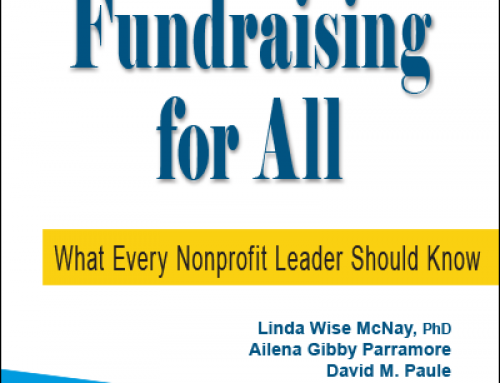At Our Fundraising Search, we spend a great deal of time helping our clients assess and improve their overall fundraising effectiveness. As we start 2024, we are observing five significant trends that we believe fundraisers and nonprofit executives need to monitor and (in most cases) embrace.
Trend #1: AI is increasing the digital divide in fundraising
Twenty-something years ago, I worked with a large population of employees who were not willing to use email. As a result, the company had to have multiple, redundant communication processes to try to ensure mission-critical information made it to them. As a young executive, I made the bold move of standing up in a meeting and announcing that the company could no longer afford employees who would not keep up with technology and that my department would no longer support those antiquated communication channels unless those employees started paying us for them.
I am lucky I made it out of that meeting alive.
My lack of subtlety aside, it was the right answer. We face a similar threshold today. Data-driven fundraising is no longer a luxury; it is the new foundation of the industry. And, A.I. Fundraising is going to supplant many of the traditional roles and activities. Fundraisers who will not put data in the donor management system, use wealth screening tools like DonorSearch to prospect, and use predictive modelling tools to anticipate donor behavior in the moves management process are simply going to fall by the wayside.
Our friends at DonorSearch published an article titled “Fundraising Intelligence: Using AI to Enhance Philanthropy” which we think offers especially good and useful insights into this.
Trend #2: The evolution of donor codes of conduct
Calls for donor “bills of rights” and greater transparency have been around for years. Recently, we’ve seen a balancing set of demands for greater donor accountability for their actions and behaviors. In the wake of the #MeToo movement, there is growing awareness – and intolerance – of sexual harassment perpetrated by donors against fundraisers and other nonprofit staffers.
Most of us who have been around the nonprofit sector for a long time have heard of quid pro quo sexual demands donors have made towards fundraisers. Many of us even have personal experiences. And, while research has shown the majority of female/women fundraisers have been subject to sexual harassment by donors, this is not strictly limited to female fundraisers. The power dynamic between sex and money flows in all directions. And, what’s worse, many fundraisers describe being victim-shamed when they resist or report that form of harassment.
There is a growing lack of tolerance for these behaviors among nonprofit leaders and responsible boards of directors. As a result, a growing number of institutions are adopting donor codes of conduct. Within our own practice, we are now revising our Board Governance training to explicitly address this.
This past summer, the Chronicle of Philanthropy published an excellent article on this topic called “Donor Codes of Conduct to Fight Sexual Harassment of Nonprofit Fundraisers Are Growing More Common” which we recommend reading.
Trend #3: The growing focus on revenue diversification in nonprofits
In any given year, we probably speak with 50 to 60 nonprofits about the challenges they face. While we have written before about the value of revenue diversification and good revenue management practices among nonprofits, this year we noticed that many more are listening to us than have in the past.
The pandemic and its aftermath exposed the structural weaknesses of many nonprofits’ revenue streams. If a nonprofit was dependent upon events, that revenue stream dissolved. If one was dependent upon foundations, those foundations may have changed giving priorities. Far too many nonprofits are dependent upon one source of revenue, and found themselves unable to pivot in the face of a crisis.
It is not uncommon for nonprofits to have ancillary revenue streams. Theaters earn revenue from bar sales; museums and hospitals receive revenue from gift shops; any organization with a building probably has looked at some form of rental income. But, these revenue streams tend to be treated as incidental and unimportant.
All forms of revenue are important for a nonprofit. Nonprofits are taking harder look at where and how they generate funds. Before you run down the path of adding a membership program or selling some merch, talk with professionals. We help nonprofits understand where their sustainable sources of revenue are, and then help them identify and scope new revenue opportunities. Diversifying revenue is like diversifying your investment portfolio. It always pays to talk to professionals.
Trend #4: Nonprofits are seeing increased turnover for (mostly) controllable reasons
In 2022, the average turnover rate for nonprofit organizations was 19%, whereas the average all-industry turnover rate was 12%. All data thus far indicates that the sector outpaced the all-industry rate again in 2023. Employee retention should be as integral to pursuing your mission as fundraising and core programming. Yet, there are many leaders among us who believe turnover is the fault of the employee.
It is not the employee’s responsibility to retain themselves. Talent retention is the responsibility of management.
Our 2023 salary and satisfaction survey validated this. While it is easy to blame compensation for turnover, our data shows that the primary drivers for turnover among nonprofit executives and fundraisers are (1) unrealistic expectations and impossible goals set without their input; and, (2) toxic workplaces, cultures, leaders and boards.
Those are, typically, controllable factors. We believe it is time for the nonprofit sector to take ownership of turnover – as opposed to playing victim to it – by aggressively trying to create work environments where employees want to remain.
Trend #5: Increased skepticism of the affiliate model
Affiliate agreements are contractual agreements that allow nonprofits to remain legally independent while collaborating on a specific project or program. These arrangements are intended to benefit organizations by sharing resources to mitigate operating costs.
National affiliate models tend to struggle from a fundraising perspective. Unless the fundraising is centralized at the “headquarters” nonprofit, it can create confusion and frustration for individual and institutional donors who find themselves receiving overlapping solicitations. Worse, donors sometimes find themselves in a custody battle over who “owns” their donations.
Affiliate models only work when (1) the parent provides clear, measurable value to the affiliate; (2) when there is a clear, coordinated process between the affiliate and the parent that make them look like they are working in concert to the donor; and (3) when the affiliate fees are transparent, reasonable, and pass an ethical-use-of-donations test.
The ethical-use test is a legitimate evaluation of where a donor’s contribution winds up. If the vast majority of the dollars stay with the affiliate and directly impact the mission of that affiliate, the happier the donors will be. However, if significant portions of the donors’ gifts are perceived to be flowing to headquarters, and (worse) are being used for purposes that cannot be clearly explained and documented, those donors are going to be rightfully skeptical of the organization.
Higher salaries and larger staffs of parent organizations fuel skepticism of the affiliate model. We believe that institutional donors in particular are going to be asking tougher questions about the value the affiliate receives from these types of relationships in the coming year.






Leave A Comment